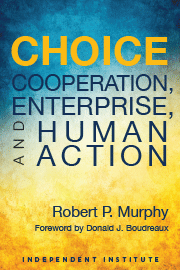A superficial observer might argue that Santa Claus has no relevance to economics, because in Santa’s world, there is no scarcity. But Santa, though magical, is not omnipotent. He faces constraints.
First, Santa only delivers tangible, conventional presents to boys and girls. If someone wrote him a letter asking for world peace, cold fusion, or a resolution of the Riemann hypothesis, I don’t think Santa could deliver. Santa is a nice guy, and he surely recognizes that, say, perpetual nutrition for the world’s poor is more important than giving Jimmy in Boise a new toy train. So we must conclude that Santa is only capable of creating and delivering specific material items to the lucky recipients on Christmas Eve.
How does Santa decide what orders to give his elves to fill that bag?
Even if we restrict our attention to specific material items, Santa still has limits on what he can deliver. His elves are busting their cute little butts 364 days of the year so he will be ready with his pile of goodies on the special night; he can’t hand out more toys than they can produce.
And while it’s true that Santa can apparently slow or stop the passage of time, and can somehow fit through chimneys (and even enter houses with no obvious access point), he still needs a reindeer’s nose to navigate through fog.
Let’s summarize the situation: Santa has information directly communicated from all the boys and girls around the world about the presents they would like, and he even seems to know each child’s ranking of potential presents. Santa’s operation at the North Pole is like a factory that can crank out items from a huge catalog, making at least one present from each child’s wish list. Yet, Santa can’t make everything from every child’s list. As he’s loading up his sleigh on any given Christmas Eve, Santa knows that if he wanted to give Susie one more doll, then at least one other kid on Earth would have had to get a different mix of toys.
Optimizing Christmas
Now we face a problem: How does Santa decide which combination of presents to produce in a given year? As he’s climbing into his sleigh on any particular Christmas Eve, Santa’s magical bag could contain a mind-boggling number of possible combinations of gifts. At the start of the season, how does Santa decide what orders to give his elves to fill that bag?
To be sure, Santa wants to bestow joy upon the boys and girls of the world. And, because they send him letters and visit him in the mall, Santa knows what their individual preferences are regarding particular presents. But that isn’t enough information. Once Santa has gone with a certain “profile” of presents—with one or more designated for each child on Earth — then any tweaking of that profile (as long as the original wasn’t obviously wasteful) will make one child happier only by making at least one other child less happy. So how does Santa compare the seemingly limitless possible profiles of presents to pick out the one that will satisfy the world’s children the most?
Ludwig von Kringle
Fans of Austrian economics will recognize that I have deliberately pushed Santa into the position of a benevolent and well-informed central planner, who has all of the good intentions and knowledge about consumer tastes that Ludwig von Mises stipulated in his critique of socialism. Nonetheless, Mises contended that such a central planner would have no recourse to economic calculation. Without market prices for the factors of production, the socialist planner has no way of evaluating whether a particular tweak to the economic plan will make his subjects better or worse off.
For example, the socialist planner might consider building an extra food distribution center—what people in a capitalist society would call a grocery store—closer to a major residential area, so that the comrades wouldn’t have to drive as far to pick up their meals. Building the center would use up lumber, steel, glass, bricks, and construction manpower, but in return it would provide a flow (over its lifetime) of extra leisure time and gasoline to the “customers” who didn’t have to drive as far. Would such a trade be worth pursuing?
Mises argued that without the profit-and-loss test provided by market prices, the socialist planner would have no way of knowing. There would be pros and cons of building the food distribution center, yet no way of coherently reducing them to a common denominator to see whether the benefits outweighed the costs.
Santa, though magical, is not omnipotent. He faces constraints.
In a market economy, a shopping developer could estimate consumer spending behavior and see whether the ongoing operating profit (calculated in present-value terms) of a new grocery store at a hypothetical location would more than cover the upfront construction costs, considering the prices of lumber, glass, steel, bricks, and labor. The socialist planner would lack these vital ingredients, because there would be no markets for these inputs—the state would own them all.
Likewise, Santa has no way of knowing whether he is giving his elves “efficient” marching orders, even though he knows how each child subjectively evaluates various combinations of possible gifts. Even though he’s magical, Santa could enhance his operation if he incorporated the information provided by market prices.
A Not-So-Magical Christmas
Consider: If Santa ordered the production of a particular bag of presents that had a lower market value than some other possible bag that his elves could have produced, then there is clearly a win-win tweak available. Santa could produce the more valuable (in money terms) bag, and then the rest of humanity could rearrange its own conventional production in order to make everybody materially richer. For example, suppose Johnny asks for a train set that would cost his parents $50 if they bought it at the store, and further suppose that the elvish resources needed to make the train at the North Pole could have alternatively been used to produce boxes of laundry detergent that would cost a total of $60 at the grocery store.
Now, the way Santa currently works—where he operates outside of the market and just answers kids’ letters, ignoring price signals—he would obviously give Johnny the train; no kid wants to get laundry detergent on Christmas morning. However, if Santa and the adults could coordinate, Santa could tell his elves to produce the laundry detergent, while the parents could buy the train at the store. There would be an extra $10 in resources freed up by this rearrangement of production, shifting train production to human factories and laundry detergent production to the North Pole. Only through market prices would Santa know best how to integrate his operation into the world economy.
To be sure, Christmas movies wouldn’t be as much fun if they depicted St. Nick as a CEO trying to please shareholders rather than as a jolly old man trying to please children. But it’s important to recognize why real-world factories should not be run like Santa’s workshop. Real-world CEOs wisely rely on market prices, rather than letters, to know what their customers desire.










